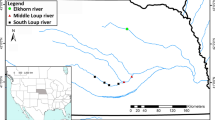Abstract
This study was initiated by suggestions that the Japanese brown alga Sargassum muticum (Yendo) Fensholt, recently found to be invading shores along the eastern Solent (Southern England), might replace certain common native plants, to the possible detriment of local epibiont communities. Eighty animal, 52 plant and 9 fungal species have been identified from S. muticum plants collected at four different localities. Animal fouling was most conspicuous on permanently submerged plants growing along the edge of floating harbour installations. Algal epibionts were most numerous and varied on S. muticum from tidal lagoons on a well-scoured but sheltered rocky shore. Most of the epibionts colonised the perennial portions of the plants, close to the holdfast. A few settled along the fronds in summer, but none were found in the region of the secondary and tertiary apical meristems. Seasonal variations in the abundance and diversity of algal epibionts were observed; most were restricted to summer, but winter and all-year-round species were also noted. Fungal studies on S. muticum have isolated only saprophytic species, which are also common locally on other Phaeophyceae. Overall, these data suggest that S. muticum can support a considerable epibiota and, therefore, its introduction seems unlikely to result in a significant change in local epiphyte communities.
Similar content being viewed by others
Literature Cited
Abbott, I.A. and W.J. North: Temperature influences on floral composition in California coastal waters, In: Proc. int. Seaweed Symp. (7, Sapporo). pp 72–79. Ed. by K. Nisizawa. Tokyo: University of Tokyo Press 1972
Anonymous: Japanese seaweed sails in. Mar. Pollut. Bull. 4 (6), p. 85 (1973a)
Anonymous: Sargassum spreads, and long vigil begins. Mar. Pollut. Bull. 4 (7), p. 100 (1973b)
Anonymous: Clearing Sargassum. Mar. Pollut. Bull. 4 (12), p. 180 (1973c)
Barnes, R.S.K., J. Coughlan and N.J. Holmes: A preliminary survey of the macroscopic bottom fauna of the Solent, with particular reference to Crepidula fornicata and Ostrea edulis. Proc. malac. Soc. Lond. 40, 253–275 (1973)
Chapman, A.R.O. and E.M. Burrows: Field and culture studies of Desmarestia aculeata (L.) Lamour. Phycologia 10, 63–76 (1971)
Conover, J.T. and J. McN. Sieburth: Effects of Sargassum distribution on its epibiota and antibacterial activity. Botanica mar. 6, 147–157 (1964)
Cribb, A.B. and J.W. Cribb: Marine fungi from Queensland — II. Pap. Dep. Bot. Univ. Qd 3, 97–105 (1956)
Druehl, L.D.: Marine transplantations. Science, N.Y. 179, p. 12 (1973)
Farnham, W.F., R.L. Fletcher and L.M. Irvine: Attached Sargassum found in Britain. Nature, Lond. 243, 231–232 (1973)
— and E.B.G. Jones: The eradication of the seaweed Sargassum muticum from Britain. Biol. Conserv. 6, 57–58 (1974)
Friedrich, H.: Marine biology [Transl. from German by G. Vevers], 474 pp. London: Sidgwick & Jackson 1969
Holmes, N.J.: The ascidian fauna of Southampton Water. Central Electricity Res. Lab. Note No. RD/L/N 187/71 (1971). (Internal publication)
Jones, E.B.G. and W.F. Farnham: Japweed; new threat to British coasts. New Scient. 60, 394–395 (1973)
Kohlmeyer, J.: Fungi from the Sargasso Sea. Mar. Biol. 8, 344–350 (1971)
—: Parasitic Haloguignardia oceanica (ascomycetes) and hyperparasitic Sphaceioma cecidii sp. nov. (deuteromycetes) in drift Sargassum in North Carolina. J. Elisha Mitchell scient. Soc. 88, 255–259 (1972)
— and E. Kohlmeyer: Icones fungorum maris, Vol. I. Fasc. 1–7. Weinheim/Lehre: J. Cramer 1964–1969
——: Synoptic plates of higher marine fungi. An identification guide for the marine environment, 3rd ed. 87 pp. Lehre: J. Cramer 1971
Marine Biological Association: Plymouth marine fauna, 3rd ed. 457 pp. Plymouth: Marine Biological Assoc. 1957
Marshall, W.: An underwater study of the epiphytes of Laminaria hyperborea (Gunn.) Fosl. Br. phycol. Bull. 2, 18–19 (1960)
Martinez Nadal, N.G., L.V. Rodriguez and C. Casillas: Isolation and characteristation of sarganin complex, a new broad-spectrum antibiotic isolated from marine algae. In: Antimicrobial agents and chemotherapy 1964, pp 131–134. New York: American Society of Microbiology 1964
Morton, J. and M. Miller: The New Zealand sea shore, 638 pp. London & Auckland: Collins 1968
Norton, T.A.: An ecological study of the fauna inhabiting the sublittoral marine alga Saccorhiza polyschides (Lightf.) Batt. Hydrobiologia 37, 215–231 (1971)
— and E.M. Burrows: Studies on marine algae of the British Isles: 7. Saccorhiza polyschides (Lightf.) Batt. Br. phycol. J. 4, 19–53 (1969)
Ogino, C.: Tannins and vacuolar pigments. In: Physiology and biochemistry of algae, pp 437–443. Ed. by R. Lewin. New YOrk & London: Academic Press 1962
Parke, M. and P.S. Dixon: Check-list of British marine algae — second revision. J. mar. biol. Ass. U.K. 48, 783–832 (1968)
Ryland, J.S.: The association between Polyzoa and algal substrata. J. Anim. Ecol. 31, 331–338 (1962)
—: Observations on some epibionts of Gulf-weed, Sargassum natans (L.) Meyen. J. exp. mar. Biol. Ecol. 14, 17–25 (1974)
Setchell, W.A.: Hong-Kong seaweeds, II. Hong-kong Nat. 2, 237–253 (1931)
Setzer, R. and C. Link: The wanderings of Sargassum muticum and other relations. Stomatopod 2, 5–6 (1971)
Sieburth, J. McN. and J.T. Conover: Sargassum tannin, an antibiotic which retards fouling. Nature, Lond. 208, 52–53 (1965)
South, G.P. and E.M. Burrows: Studies on the marine algae of the British Isles: 5. Chorda filum (L.) Stackh. Br. phycol. Bull. 3, 379–402 (1967)
Stubbings, H.G. and D.R. Houghton: The ecology of Chichester Harbour, S. England, with special reference to some fouling species. Int. Revue ges. Hydrobiol. 49, 233–279 (1964)
Tubaki, K.: Studies on the Japanese marine fungi, lignicolous group (III), algicolous group and a general consideration. Ann. Rep. Inst. Fermentation, Osaka 4, 12–41 (1969)
Author information
Authors and Affiliations
Additional information
Communicated by J.H.S. Blaxter, Oban
Rights and permissions
About this article
Cite this article
Withers, R.G., Farnham, W.F., Lewey, S. et al. The epibionts of Sargassum muticum in British waters. Mar. Biol. 31, 79–86 (1975). https://doi.org/10.1007/BF00390650
Accepted:
Issue Date:
DOI: https://doi.org/10.1007/BF00390650




